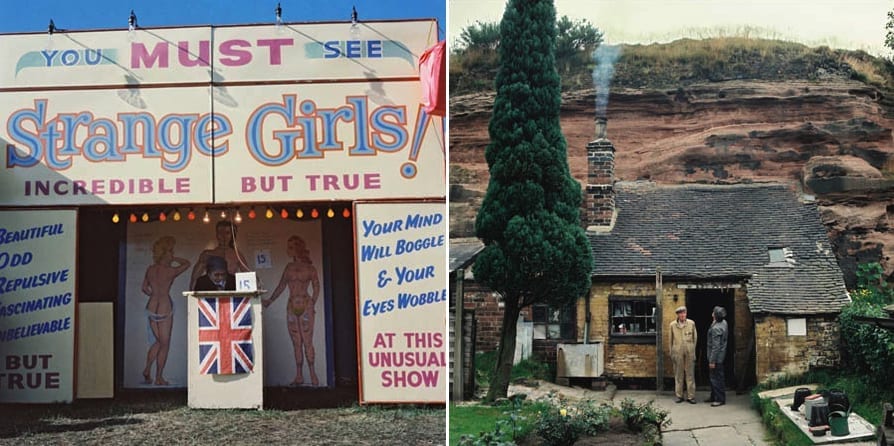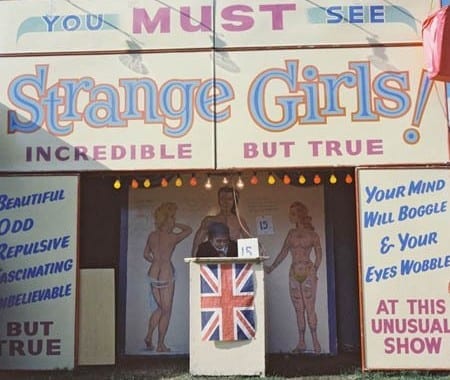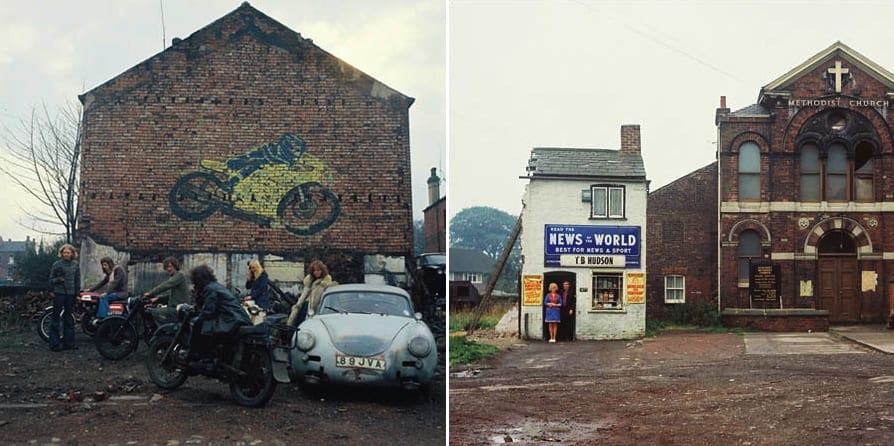
Mitchell dealt in discrete spaces and identified portraits, all bounded by comedy and geographic spots on Mars and Leeds. But Mitchell’s photographs were also locales for familiar industrial pastoral spaces, marred and broken by the same sense of contemporary cultural collapse which haunted Duff.
Peter Mitchell- A New Refutation of the Viking IV Lander (Essay published in 2005)
By Professor David Mellor, University of Sussex
Mitchell dealt in discrete spaces and identified portraits, all bounded by comedy and geographic spots on Mars and Leeds. But Mitchell’s photographs were also locales for familiar industrial pastoral spaces, marred and broken by the same sense of contemporary cultural collapse which haunted Duff. Mitchell’s Impressions Gallery exhibition of ANRVL, in January 1980, was mostly populated by vanishing figures involved in declining industries- engineering, cold steel rolling -those sectors which had been in a state of accelerated dereliction and were now, in the Year Zero of Mrs. Thatcher’s restructuring of British industry, being extinguished [17.] . [17. For example, in the winter of 1979-80, her Conservative Government announced plans for the drastic contraction of steel manufacturing in the UK through enforced plant closures] In Mitchell’s photographs both human figures and built environment were celebrated as beautiful in colour -chromatic jubilations of factory walls and stained glass fish shop windows. But a valedictory mood is inescapable in his commentary, which is empirically and sentimentally specific at the other end of a spectrum from Duff’s unidentified inhabitants of cities. There were metaphors of catastrophe in Mitchell’s mind: in his diary entry for 12th February 1978, while photographing the Quarry Hill flats in the snow, he compares them Stalingrad. In this image was a portent of that social war which was about to erupt into the ‘Winter of Discontent’, a year later, and a year before his NRVL exhibition was mounted. Even beyond Leeds all things are in collapse- Mitchell’s portrait of Max Babbin is captioned with a glancing summing up that, despite his physical decrepitude, he “is in a better situation than British Leyland” . He is one of a cast of persistent survivors who are nevertheless about to lose their livelihoods or see their businesses close, or are adapting to hard times by small business initiatives- (two men firms seem typical). Mitchell lists wonderful instances of Leeds’ migrant past and present- Mr. Reuben and Mr. Jakinvicius. They take their place in what appears to be a city of the aged, the passed by and the redundant, the ungainly, who are to be celebrated as if Alan Bennett had met Diane Arbus in an urban picaresque which forms an important element in Mitchell’s work , especially in the NRVL series.
But beside the grotesque human plenitude of these survivors there are always the portents of physical and material absence : the printers, Warren Jepson, whose trade name appears in digitized writing in the frames of the ANRVL series have closed, eventually, after being absorbed into an American based trans-national company. So we can say that Mitchell recorded evidence of the pathos of the uprooting and disappearance of urban industries and in 1983, Raymond Williams would diagnose this as a key theme of late 20th. century Britain: “… elements of the industrial mode of production itself can now be perceived as inflicting kinds of damage on people and on the physical environment which were not fully recognized when the system was more successful, you have again this curious confusion and mis-recognition. It’s apparent in discussions of what’s called ‘de-industrialization’: that on the one hand people are regretting the collapse of the traditional British industries, the old heavy industries….and on the other hand are recognizing that going out with those jobs are some of the most dangerous kinds of work…. there’s a very curious interlock between the sense of loss and of dereliction, ” [18 ]. [18. Raymond Williams ‘Problems of the coming period’, in Resources of Hope , Verso, London 1989, pp.161-174, p. 167.] There is something here which relates to Peter Mitchell’s complex colour reportage spectacles of Leed’s decline in the 1970’s: where ‘Noel and his lads’ stand demolishing Quarry Hill as a kind of Piranesian stage of the passing of the industrial era of modernity, they stand bound together, nostalgic in their union, but surrounded by an epic wreck, performing the larger dereliction, while defying loss. And it was for his future memories that Noel, the Foreman of the Leeds Quarry Hill demolition squad, asked Peter Mitchell on 12th. February 1978 for, “some snaps as he said nobody else was bothering and he needed some for his scrapbook of all the places [he’s] demolished- like telling your kids in 20 years time!” [ 19] . [19. Peter Mitchell Journal entry, 12th. February 1978, Peter Mitchell Archive, Leeds.] What Mitchell performed at Quarry Hill was a knowing revival of the celebratory vernacular frontal group portrait. In many ways this became a prevelant form- an index of revived communality on the temporal edge of the social re-structuring of the 80’s, or sub-group solidarities , visible in Daniel Meadows’ Pylon Painters, Great Washburne, Gloucestershire , or, of course in Mitchell’s Noel and his Lads…
NASA’s 1976 Viking Landers were a triumph of robotics, of remote sensing and imaging- that very culture of digitized information which was to supplant the manual world of industrial era Leeds- on an unknown planetary surface: Mitchell used this haunting paradigm to de-familiarise the conventions of photographic urban topography. Another way of considering ANRVL – in its distinctive displacement of Leeds to Mars – would be in relation to the kinds of geographies of science fiction which have been examined in Kitchen and Kneale’s Lost in Space [ 20 ]. [20. R. Kitchen and J. Kneale Lost in Space ,Continuum, London, 2002.] In his documentation of collapsing states of technology in a decaying industrial environment, Mitchell, at the end of the 70’s, presaged cyber-punk commonplaces of the 80’s, by his antinomian interleaving of the sites of Mars with places in Leeds. The exhibition was laid out, in York, in 1980, with spatial interruptions of Leeds’ social and physical fabric by NASA photographs of specific locations on Mars, like Chryse Planitia in the Utopia Planitia zone, the basin where the first Viking Lander touched down in 1976.
After a period at Hornsey College of Art, from 1968 to 1972, Mitchell arrived in Leeds at Christmas 1972, joining his architect partner- Diane -who was working in Burnley as part of a local initiative to save the inner-city terraces from demolition: part of that swing away from Modernist imperatives in urbanism and back to low-rise housing. He started making photos of the Chapeltown locality- and particularly his house and street, from which he has not moved- Spencer Place -from the moment he moved to Leeds. Mitchell’s comic homely but also uncanny narratives were rectified by his surveyer-like gaze of numbered co-ordinates and digital lettered evidence which literally borders the scenes of ANRVL. This rectifying screen, bordering a world of enigmas and buildings, would fictionally emerge only two years later with the framing screen of the doomed topographer in Peter Greenaway’s film The Draughtsman’s Contract . Mitchell’s cartographic imagination of cities was formed during his time at The Ministry of Housing in Whitehall- in a drawing office -as a draughtsman, straight from school, in 1959, and later for Colin Buchanan and Partners. In this latter job he devised city plans which registered preferred human traffic routes- kinds of bureaucratized pyscho-geographic drift -called ‘desire lines’ on the road to what Buchanan called ‘full motorization’. The dust jacket design for Ian Sinclair’s London Orbital used Mitchell’s ‘Desire Line diagram’ [ 21], [21. Colin Buchanan Traffic in Towns 1963, p. 58.] for Newbury. This rationalized imaging of mechanized flows as ‘desire lines’ suggests a parallel , but equally technologized form of representation as Mitchell’s ANRVL with its gridded absurdities and gratuitous locations. Behind so much of art and photography of this moment was the positivist belief in the power of the scientific or technical format; such that Euan Duff, too, wished to assemble HWA through linear bandings, conceptualized by him as a ‘list of different arrows on a flow chart which I wanted to relate together…..the whole thing had a logical systematicity” [ 22]. [22. Euan Duff in conversation with the author, 25th. July 2005.] Yet, as with Mitchell, this systematicity might be a congruent frame for a melancholy view of an instrumentalized, brutal world.

